There really isn’t anything quite like a Sealed Pack tournament to give you an appreciation for a new set.
I just got back from $10K Orlando. Despite the fact that I didn’t finish in the money, I had a very good time at the final $10K of 2006. The Legion of Super Heroes set may very well be one of the most complex sets to date for Sealed Pack formats because there is no visible archetype that appears to be stronger than the others.
The weekend turned out to be perfect for a tournament in the fair weather of Kissimmee, Florida. A temperate climate allowed Vs. System players to battle fiercely at the tables during the tournament, and then settle outside on the hotel patio afterward for a variety of activities . . . including ping pong!
He Moves Quite Fast for a Big Guy
On Sunday morning, I happened to run across Adam Prosak and Craig Edwards engaging in a friendly game of ping pong on the hotel terrace. Now, while I may never have been the caliber of ping pong player that some of the West Virginian Vs. System players are, I was actually quite good back in college. You see, I lived in a dormitory with mostly foreign students. As I found, ping pong is much more popular abroad than it is here in the US of A, so I took the opportunity to learn a few things about the game. At first, I was awful. I couldn’t tell the difference between a back spin and a front spin, much less how to actually hit a ball with any kind of spin on it. But after a great deal of practice (and patience by my “coaches”), I started to learn the nuances of the game. Before long, I was hitting the ball with precision and accuracy and winning more games than I lost.
I wasn’t sure if I still retained any of this skill. If I had, I felt that I would have little problem dispatching Adam or Craig. So I made the off-hand remark that while either could beat me at Vs. System (as they both had before), I thought I could take them at ping pong. Adam kind of chuckled at this and took my challenge.
Sadly, I found out that playing ping pong is not like riding a bike. I played horribly! Worse yet, I discovered that Adam was slow-rolling when he played Craig, and that he was actually a much better ping pong player than he had first appeared. The end result was that Mr. Prosak utterly thrashed me, 15-7. I guess the only way I’ll ever get the best of the Pro Circuit Champ is to challenge him to balancing a general ledger, or some other accounting-related task. It would be just my luck that he turns out to be a better accountant than me, too!
A Card in the Hand is Worth Two in the KO’d Pile
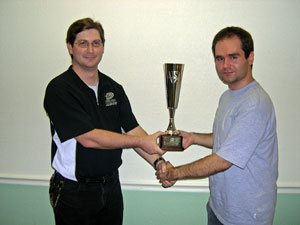
After my humiliating defeat at the hands of the PC Champ, I took the opportunity to play a friendly game against Craig Edwards. We didn’t keep score, as we thought it might have been a bad omen; Craig was in the finals of the $10K! Sure enough, our avoidance of point totals and silly things like who won or lost turned out to be a good idea. Craig walked into the tournament finals after our forty-five-minute ping pong match and dispatched Will Raiman in two straight games. Will’s deck was good. So good, in fact, that I am sure that the only reason Craig won was the good luck brought on by our ping pong match.
Okay . . . maybe Craig’s drafting and play skill had something to do with his win.
Craig’s $10K-winning deck was a vicious concoction of Future Foes and Teen Titans with a particular emphasis on Future Foes discard effects. Although I had to leave to catch my flight, I did read the match coverage of the finals. One exchange between the two players particularly caught my attention:
Cosmic King attacked Dark Thanagarian, and Craig made use of his ability. With the ability on the chain, Will removed Spark’s counter to flip Many Worlds, and then replaced it to draw a card. He discarded to counter the King’s ability, and Craig played Tempus Fugit. Will ditched another card. Craig had yet another trick in the form of a power-up. Will had nothing to answer this and simply reinforced.
This attack was emblematic of the tricks that Craig displayed throughout his Top 8 matches with his Future Foes deck. With such a large number of discard effects, he was able to force his opponents to drain their hands to keep up with him. With enough of these hand-draining battles, Craig was able to win the wars against his opponents convincingly.
Hand Control: A New Perspective
The Future Foes discard theme got me thinking about the possibility of hand control decks in Vs. System. In other TCGs, hand advantage is a critical component of any successful deck. Take a game like Yu-Gi-Oh! as an example. There are numerous cards, like Don Zaloog and Spirit Reaper, whose sole purpose is to drain your opponent’s hand. Without a hand, an opponent has fewer options with which to fight back, thus giving you an inherent advantage in the game.
In Vs. System, though, hand control has not found a lot of success. There are probably a number of reasons for this, such as the mechanic of drawing two cards each turn, being able to utilize cards in your resource row, and the ease of recursion. In essence, hand advantage is nowhere near as critical in Vs. System as in other TCGs because it is nearly impossible to eliminate a significant number of in-game options. The one deck that found success with hand control—TDC’s infamous Ivy League deck from PC: San Francisco—was actually too abusive and resulted in the banning of Justice League of Arkham. I suppose the bottom line is that using hand control as a tool to eliminate opposing options to the degree that it becomes totally effective is bad for the balance of our game.
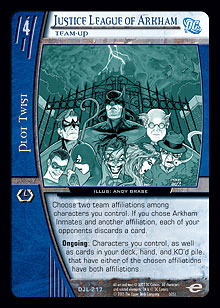 Obviously, UDE had no intention of allowing something like Ivy League to happen again, so they balanced the power of the discard effects available to the Future Foes. What made Justice League of Arkham so debilitating was that it a required discard whenever it was played. If a clever player flipped the Team-Up during the build phase enough times, an opponent would not have any cards to play for that turn. In contrast, the Future Foes have two distinct types of discard effects: optional discard effects for outside of the combat phase (like Lightning Lord) and combat-phase only discard effects (like Computo). This serves to balance the discard effects of the Future Foes—they can be annoying, but certainly not abusive.
Obviously, UDE had no intention of allowing something like Ivy League to happen again, so they balanced the power of the discard effects available to the Future Foes. What made Justice League of Arkham so debilitating was that it a required discard whenever it was played. If a clever player flipped the Team-Up during the build phase enough times, an opponent would not have any cards to play for that turn. In contrast, the Future Foes have two distinct types of discard effects: optional discard effects for outside of the combat phase (like Lightning Lord) and combat-phase only discard effects (like Computo). This serves to balance the discard effects of the Future Foes—they can be annoying, but certainly not abusive.
So, what is it about the Future Foes that makes them special? If their discard effects aren’t abusive, then there doesn’t seem to be any point to playing the hand control theme. Here’s where Mr. Ben Seck and UDE R&D got clever! As we have discussed, other TCGs use hand disruption to control their opponent’s options. But we’ve also said that having that level of control in Vs. System is too abusive. Where did TBS and UDE find the happy medium? By giving Future Foes significant bonuses based on the hand control theme. Take a character like Cosmic King. Your opponent is under no requirement to discard for Cosmic King’s payment power; however, if his payment power does resolve successfully, then Cosmic King will usually be bigger than any opposing 3-drop and big enough to stun most opposing 4-drops. In essence, if your opponents want to keep their cards, then they’re going to pay a different price.
Dipping Back into the Binder for Some of those Forgotten Rares
One unique aspect of the Future Foes is that they are the first team to have a consolidated discard theme. There have been other teams with a smattering of discard-based effects—X-Men, Marvel Knights, and Arkham Inmates—but none of these teams really had enough cards to support a full discard deck.
This opens up some possibilities for cards that have been forgotten over the course of time. In a Future Foes build, these cards could be absolutely devastating. Consider the TDC Stall deck that found so much success at PC: L.A. 2006. Aside from its ability to supplement the player’s hand, one of the key traits of the deck was a heavy emphasis on locations. Imagine now how effective a card like Concrete Jungle would be: in order to get their locations face up once more, opposing players would likely have to discard their entire hand.
Another fun card for the discard theme is Mystic Chain. This equipment card was the focus of my column nearly a year ago. The key to this card is that it creates a two-card swing when you deal breakthrough—your opponent loses one and you gain one. Even with just two or three successful attacks with Mystic Chain, it can create such an overwhelming advantage that your opponent may not have any chance of recovering.
But the card that caught my eye above all others is Museum Heist. I daresay that this may be the perfect card for the Future Foes theme. As we said earlier, the Future Foes make a trade on getting bonuses if opponents fail to discard. In that respect, Museum Heist fits the theme to a tee, netting us two cards when our opponent doesn’t discard. In the past, an opponent would usually have taken the single card hit to prevent our hand acceleration. But with the bag of goodies that the Future Foes have in store, our opponents may just want to keep their cards to themselves. In any case, it’s a win-win situation for us!
Catwoman has been dangling from the ceiling long enough. It’s time for the Future Foes to join her in a Museum Heist—one that is sure to net us a pretty assortment of cards while leaving all of our opponents’ treasures in the KO’d pile.
The Build
 Four copies of Museum Heist will join the build, along with our other “forgotten treasures”—three copies of Concrete Jungle and four copies of Mystic Chain. By themselves, these cards are already a powerful discard force. Once we place them in the Future Foes setting, though, we won’t have any problem forcing our opponents to discard their hands.
Four copies of Museum Heist will join the build, along with our other “forgotten treasures”—three copies of Concrete Jungle and four copies of Mystic Chain. By themselves, these cards are already a powerful discard force. Once we place them in the Future Foes setting, though, we won’t have any problem forcing our opponents to discard their hands.
Along with our generic discard effects, we have some team-specific plot twists. Our first (and probably most obvious) choice is Chain Lightning. While the -2 DEF conferred by Chain Lightning is certainly reasonable, it is the second part of the effect that we are most interested in. Barring a discard on our opponent’s part, Chain Lightning takes away an additional -2 DEF from an opposing attacker or defender. This extra -2 DEF may not seem like much, but it is far more formidable than it first appears. Consider that in the mid- to late curve of most decks, the difference between the ATK of lower drops and the DEF of higher drops is 3 points. In this regard, stunning up the curve requires a 3-point ATK boost. This is where the “difficult decision” comes into play. Without a discard, Chain Lightning is a large enough pump to stun up the curve. So, our opponents will often be presented with the tough choice of taking the stun or discarding to possibly avoid it. If we can parlay a discard into a stun (maybe with another copy of Chain Lightning), then we have the best of all possible worlds for us.
Now let’s take a look at a card that can translate hand advantage into board control. Most off-curve decks like Faces of Evil and Kree press tend to drain their players’ hands from the multiple cards played each turn. In fact, these decks often go into their kill turn with no cards in hand. This makes a card like Sorcerous Suppression amazing. When our opponent has no cards in hand, Sorcerous Suppression is a free exhaust of a character for us. Even in the situation where an opponent has a card or two left in hand, Sorcerous Suppression creates another tough choice for our opponent by forcibly trading a card in hand to keep a character ready. If we force the discard of an ATK pump, it can often be a trade in our favor.
Finally, let’s look at Altered History. Recovery effects are never bad, and this one is amazing in our build. In combat oriented decks, the major goal of any build is to create favorable character trades. Attacking up the curve can be a powerful strategy, as it creates a later opportunity to attack down the curve, often without a stunback. Recovery effects can also sway combat by effectively giving a player an “extra character,” so to speak. In situations where an opponent is working to gain board advantage, keeping an extra character in play can impede chances for an opponent to advance that goal. In almost every situation, an opponent would prefer to discard than to allow us to recover. But in situations like the aforementioned off-curve decks, this could very well not be an option. In essence, there is a high likelihood that Altered History is simply a free recovery for us.
Our plot twists are not going to be limited just to discard effects. We also need to consider our character search options. Unfortunately, the Future Foes do not have a character search card that relates to the discard theme; it would be pretty cool if they did. But the Future Foes do have Fatal Five Hundred. Unlike other character search cards, this one requires a bit of planning. With several hidden characters in the Future Foes, we will often have the chance to attack an opponent for breakthrough; we can transform that into a character search for us. It’s conditional, but still quite good nonetheless. Also, we’ll toss in a couple copies of the new money rare on the block, Mobilize. Since we’re going to be playing a mono-team deck, I thought it would be fun to give Mobilize a spin. Much like Enemy of My Enemy, Mobilize has the potential to change the Vs. System metagame. For our deck, it’s simply another way to ensure that we hit our optimal drops.
For anyone who has enjoyed a significant amount of Legion of Super Heroes Sealed Pack play, our character choices will seem rather apparent. Still, it wouldn’t be Breaking Ground if we didn’t discuss these choices thoroughly. Our 1-drop is easily one of the most important cards in our deck. The Demon’s Head is indeed back, and he’s gone into politics. Ra’s al Ghul ◊ Leland McCauley has a great deal going for him. First and foremost, he’s a 1-drop with an alternate recruit cost. This means that even if we fail to find him on the first turn, he will still be useful in later turns. Secondly, he has a relevant effect for our deck. Considering that we already have some breakthrough-based effects (Fatal Five Hundred and Mystic Chain), we can benefit from a card that can eliminate reinforcement options. Of course, our opponent could discard to counter Ra’s al Ghul. But this still favors us, as forced discards give us more opportunities in later turns. Finally, Ra’s has concealed. This makes him the perfect character to use with Museum Heist. Considering that Ra’s al Ghul has a “return to hand” effect, our opponent won’t usually waste an attack or stun effect (like Mikado and Mosha) on him. In essence, he will usually be around and ready at the start of the recovery phase. More cards for us!
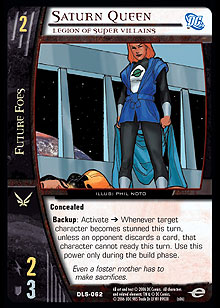 Moving on to our 2-drops, we’re going to start off our representation from the Legion of Super Villains with Saturn Queen. With flight and concealed, Saturn Queen is a respectable 2-drop regardless of effects. In later turns, though, she has a backup payment power that can put our opponents in a pickle. Obviously, our opponents will always want to ready their characters to take full advantage of turns when they control the initiative. Saturn Queen forces a difficult trade for our opponents by forcing a discard if our opponent wishes to ready a stunned character. Once again, tough choices. Our other 2-drop doesn’t present difficult decisions for our opponent, just a very large character. Stat-wise, Tarik the Mute is the biggest 2-drop in Vs. System. With the ATK and DEF of many 4-drops, Tarik could easily be a tough force for our opponents to deal with. He does come with the drawback that his stats drop for every card in our opponent’s hand, though. Given an average hand size of four cards, this puts Tarik at a respectable 3 ATK / 3 DEF, but with our deck Tarik can become much, much bigger with little effort. Often, our opponents will have to pitch so many cards for our discard effects that they won’t be able to keep Tarik under control. And against a deck that naturally maintains few cards in hand (like Squadron Supreme), Tarik is a trump card.
Moving on to our 2-drops, we’re going to start off our representation from the Legion of Super Villains with Saturn Queen. With flight and concealed, Saturn Queen is a respectable 2-drop regardless of effects. In later turns, though, she has a backup payment power that can put our opponents in a pickle. Obviously, our opponents will always want to ready their characters to take full advantage of turns when they control the initiative. Saturn Queen forces a difficult trade for our opponents by forcing a discard if our opponent wishes to ready a stunned character. Once again, tough choices. Our other 2-drop doesn’t present difficult decisions for our opponent, just a very large character. Stat-wise, Tarik the Mute is the biggest 2-drop in Vs. System. With the ATK and DEF of many 4-drops, Tarik could easily be a tough force for our opponents to deal with. He does come with the drawback that his stats drop for every card in our opponent’s hand, though. Given an average hand size of four cards, this puts Tarik at a respectable 3 ATK / 3 DEF, but with our deck Tarik can become much, much bigger with little effort. Often, our opponents will have to pitch so many cards for our discard effects that they won’t be able to keep Tarik under control. And against a deck that naturally maintains few cards in hand (like Squadron Supreme), Tarik is a trump card.
At 3, Cosmic King is good. Really good. Our 3-drop is already a good-sized 5 ATK / 4 DEF with concealed. As long as we maintain his cosmic counter, though, he’ll either become a 7 ATK / 6 DEF or force our opponent to discard. Either way, we win. Still, there’s probably another character that we’d rather have on turn 3. With the current prevalence of search effects in Vs. System, Time Trapper is highly sought after. He starts with very good stats at 5 ATK / 5 DEF. But that’s only the beginning for our 3-drop, as he makes investments in search effects cost so much more! Gone are the days where Kyle Rayner, Last Green Lantern nets a player a free card; now it’s a card-for-card trade. Poison Ivy, Deadly Rose and Ahmed Samsarra are now fair trades, as our opponents have to sacrifice hand advantage to search out their precious locations (and then even more cards once we flip Concrete Jungle . . . HA HA HA HA HA!). Finally, Enemy of My Enemy becomes a huge investment, requiring two discards (not to mention the copy of Enemy of My Enemy itself). When we’re forcing our opponents into three-for-one trades, it won’t be long until they have nothing left to discard.
If Time Trapper has taken care of business on turn 3, we should be sitting quite pretty on turn 4. Our primary character will be Lightning Lord. Once again, we’ll play a card that forces our opponents into an uncomfortable position: either they discard one of the (hopefully) few cards remaining in their hands, or they have to deal with a 9 ATK / 9 DEF 4-drop. Not a pretty picture. Of course, Starfinger has the potential to be just as nasty. Starfinger is effectively the same size as Lightning Lord (with the two +1 ATK / +1 DEF counters, of course). In addition, we will always get those impressive stats from him. He does have a slight drawback in that he allows our opponents to get an extra character in play, but if we’ve done our job before turn 4, this shouldn’t be an issue—our opponent won’t have a character in hand to bring out for Starfinger’s effect. In any case, he will be a large guy on our side of the board that gives us more possibilities for draining cards from our opponent’s hand.
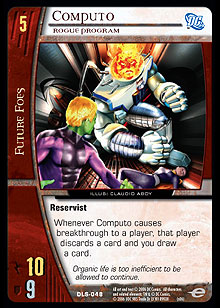 Turn 5 is all about Computo. Truth be told, the Future Foes have some very good 5-drops in Ra’s al Ghul, Engine of Change and Atrophos, but we’re going for all-out hand advantage. Much like Mystic Chain, Computo can translate into a two-card advantage for us. With the number of cards in our opponent’s hand being so relevant to the strength of our deck, this is too good a character card for us not to play. Just imagine the frenzy we could create if we dropped a Mystic Chain on Computo. Extreme hand advantage, FTW!
Turn 5 is all about Computo. Truth be told, the Future Foes have some very good 5-drops in Ra’s al Ghul, Engine of Change and Atrophos, but we’re going for all-out hand advantage. Much like Mystic Chain, Computo can translate into a two-card advantage for us. With the number of cards in our opponent’s hand being so relevant to the strength of our deck, this is too good a character card for us not to play. Just imagine the frenzy we could create if we dropped a Mystic Chain on Computo. Extreme hand advantage, FTW!
Our 6-drop has flight, range, and invulnerability. Okay . . . so his invulnerability is conditional. Still, by the time we reach turn 6, we should have whittled our opponent’s hand away enough to ensure that Ol-Vir is always invulnerable. In the late game, a large part of the damage that players take is from their bigger drops stunning. We can’t necessarily keep our 6-drop from stunning, but we should be able to keep it from hurting so much.
Finally, at 7, we have Shrinking Violet ◊ Emerald Empress. The end result of all of our hard work forcing our opponents to discard their hands should be an unmatched 7-drop. At 15 ATK / 17 DEF, Shrinking Violet is already pretty big for her cost. But once we force our opponent to ditch that final card, Shrinking Violet leaps to 19 ATK and gains flight. At this size, our 7-drop is a match for most 8-drops. And considering that our opponents won’t have any cards in hand, it’s highly probable that they won’t hit their 8-drops anyway!
Much like my good friend Strong Bad, we are ready to pursue our own jumble caper. Let’s see what we can heist with our completed Future Foes build:
The Cheat is Not Dead (60 cards)
Characters (32)
4 Ra's al Ghul ◊ Leland McCauley, U.P. President
4 Saturn Queen, Legion of Super Villains
4 Tarik the Mute, Legion of Super Villains
2 Cosmic King, Legion of Super Villains
4 Time Trapper, Temporal Manipulator
4 Lightning Lord, Legion of Super Villains
1 Starfinger, Char Burrane
4 Computo, Rogue Program
3 Ol-Vir, Legion of Super Villains
2 Shrinking Violet ◊ Emerald Empress, Emerald Vi
Plot Twists (24)
3 Altered History
4 Chain Lightning
3 Concrete Jungle
4 Fatal Five Hundred
2 Mobilize
4 Museum Heist
4 Sorcerous Suppression
Equipment (4)
4 Mystic Chain
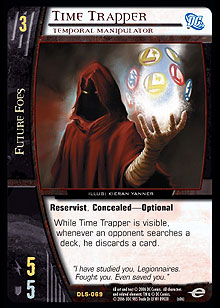 The deck will undoubtedly run best with the odd initiatives. This gives you a chance to get Time Trapper into play on turn 3 before your opponent can set up with search effects (like Enemy of My Enemy, for example). With a few discard tricks in the early turns, this also allows you to bring out Lightning Lord or Starfinger on turn 4 after your opponent has recruited. With any luck, your opponent won’t have a card to discard for your 4-drop’s effect, and you’ll gain a massive character. On turn 5, you should be able to put the game out of reach with Computo (hopefully equipped with a Mystic Chain).
The deck will undoubtedly run best with the odd initiatives. This gives you a chance to get Time Trapper into play on turn 3 before your opponent can set up with search effects (like Enemy of My Enemy, for example). With a few discard tricks in the early turns, this also allows you to bring out Lightning Lord or Starfinger on turn 4 after your opponent has recruited. With any luck, your opponent won’t have a card to discard for your 4-drop’s effect, and you’ll gain a massive character. On turn 5, you should be able to put the game out of reach with Computo (hopefully equipped with a Mystic Chain).
The deck should stay consistent with six search cards and several draw and cycling effects. With a mulligan for a mid-game curve (counting character searchers as drops), you should have little problem hitting your drops. You do not want to mulligan away too many 2-drops, though, as they are fairly critical to have in play on turn 2 (so that you can use either Fatal Five Hundred or Mobilize to search out your all-important 3-drop).
The key to this deck is to force your opponent into difficult decisions when it comes to discarding. Cards like Sorcerous Suppression and Altered History can literally shift the balance of games, but only if played at the appropriate time. If your opponents are playing more aggressive decks, then wait until they commit most of the cards in their hand before playing yours. Against a more control oriented deck, it may be more important to force cards out of an opponent’s hand to prevent a strong late game.
And so ends the last Breaking Ground of 2006. Over the next couple of weeks, Metagame.com is giving the writers some time off for the holidays. In the meantime, you’ll be entertained by some of the writers’ past favorites. I have a couple of fun articles picked out for your amusement.
Enjoy the holidays, and I’ll see you again in 2007!
Michael Barnes (a.k.a. BigSpooky) is an avid Vs. System player who is a founding member of Team Alternate Win Condition (TAWC). When he isn’t concocting crazy deck ideas that no sane person would think of, he occupies his spare time working as an accountant in Dallas, TX. Any questions, comments, suggestions, or jumble capers that you might have for Michael can be sent to him at BigSpooky1@hotmail.com.